WISCONSIN - Wisconsin DNR continues to lead a process of rule development aimed at addressing the statewide problem of nitrate contamination of drinking water.
WDNR’s Chris Clayton (formerly DATCP’s CAFO Program Coordinator) is the project lead on the rule development process.
The WDNR, along with the Department of Agriculture, Trade and Consumer Protection (DATCP) are now eight months into a 30-month process to pursue rulemaking to develop targeted agricultural runoff standards for areas of the state with an underlying geology that puts ground and surface water quality at risk. They held their first meeting in February, and will meet next in Stevens Point on May 28.
The NR-151 Technical Advisory Committee met via teleconference on Thursday, April 23, to hear expert testimony about nutrient management plans and nitrogen use efficiency. On the agenda was expert input from Carrie Laboski, Soil Scientist from UW-Madison Extension; Steve Hoffman of InDepth Agronomy; Dodge County farmers Tony Peirick and Dale Macheel; Abby Augarten of UW-Discovery Farms; and Joe Baeten and Brian Weigel of the Wisconsin DNR.

Current regulations
The WDNR’s Joe Baeten discussed nutrient management plans (NMP), which producers are required to have them, and what laws and rules guide the standards that producers are required to achieve.
“A NMP is a tool for a farmer or producer to manage the amount, source, method of application and timing of plant nutrients and soil amendments,” Baeten explained. “The tool used to develop NMPs is SnapPlus.”

Rules governing NMP’s include NR 151.07, and ATCP 50.04. NMPs developed for operations governed by a Wisconsin Pollution Discharge and Elimination System (WPDES) permit (CAFOs) must also comply with NR 243.14. Nitrogen specific requirements are contained in the USDA-NRCS 590 standard. In addition, NMPs must comply with the nutrient application guidelines in the A2809 publication from UW-Extension.
“NMPs start out as a planning tool to help farmers comply with local, state and federal rules and to ensure maximum economic return,” Baeten said. “But NMPs are constantly changing and require frequent maintenance.”
Baeten made possible recommendations about rules that could limit potential for nitrogen leaching in vulnerable soils:
• Improve nitrogen use efficiency from DATCP
• Avoid fall commercial N applications on medium and fine-textured soils, or if applied, use ammonium forms of nitrogen and delay application until soil temperatures drop below 50 degrees
• Consider a nitrification inhibitor for liquid and slurry manure
• Use irrigation strategies to minimize leaching
• Use a preplant soil nitrate test with wheat
• Identify direct conduits to groundwater in karst overlain by less than 50 feet of soil, and use management practices to limit leaching
• Require all crop and livestock producers to have a nutrient management plan.The WDNR’s Brian Wiegel explained that there are other sources of nitrogen that are not regulated by NR 151, but are regulated by other rules. Those sources include septage, biosolids, industrial waste, and animal waste from CAFOs and non-permitted farms.
“Wisconsin cropland is estimated to be around nine million acres,” Wiegel said. “It is estimated that 50-60 percent of nutrients applied to cropland come from manure.”
Wiegel informed the committee that 0.9 percent of nutrients applied to cropland come from septage; 0.8 percent from biosolids; 3.9 percent from industrial waste; 10 percent from CAFOs; and a combined 84 percent from non-permitted livestock farms or farms applying commercial fertilizer only.
Farmers lead
Perhaps the most inspiring part of the meeting was the last presentation provided by two Dodge County farmers, Tony Peirick and Dale Macheel. Both are leaders in the farmer-led Dodge County Farmers Watershed Council.

Peirick who farms near Watertown has hosted nitrogen use efficiency studies on his farm since 1999. The first study lasted 10 years, and the second was a three-year study, from 2015 to 2018.
“Matt Hanson conducted research on our farm for 10 years, and his primary goal was to understand the relationship between rates of application of nitrogen and yield,” Peirick told the committee. “Those were different times back then – no one was concerned about nitrate in water, and nitrogen was cheap.”
In 2015, he decided to allow further research on his farm to see if the data from the first study was still relevant to his operation, and to help with UW-Discovery Farm’s nitrogen use efficiency research.
“What was nice about the UW-Discovery Farms research is that it put together a lot of partners in one research project,” Peirick said. “In the first study, it was just the farmer and the university – in this study, we also worked with the county, and our watershed council helped to finance the study.”
The UW-Discovery Farms research helped Pierick to understand what the economics of pursuing yield with application of nitrogen was on his farm. The sweet spot, he discovered, was 85 pounds of nitrogen resulting in a yield of 209 bushels per acre at 18.8 percent moisture.
“After that, if I added another 60 pounds, it only got me four more bushels per acre yield, and led to a $7.80 per acre loss,” Peirick explained. “If I added 103 more pounds of nitrogen per acre, it got me nine more bushels per acre and resulted in a $6.30 loss per acre.”
Peirick says his big take away is that he gets his best result from a no-till system with cover crops for improved soil health.
“I’ve learned that rye is an excellent scavenger of nitrogen, and when you combine that with a Midwest BioAg molasses starter, it makes the nitrogen even more available,” Peirick said. “On some of my fields, I’ve achieved 110 percent use of nitrogen applied, and increased my profitability.”


Dale Macheel of Randolph, became involved with Discovery Farm’s research to learn about how much nitrogen he needed to supply to his crops as well. After three years of participating in the study, Macheel has revolutionized his production system with elimination of tillage, cover crops and even planting green (planting cash crops into a living cover crop).
“The research demonstrated that when I increased nitrogen application from half rate to full rate, only 14 percent of the additional fertilizer was taken up by the corn grain,” Macheel said. “This means that 90 pounds per acre of nitrogen was not used to increase yields, and actually resulted in a net loss of $15 per acre.”
In the future, Macheel says his plans are to follow grain with a cover crop, and then a half rate application of nitrogen the following year. He said he would use no up front application of nitrogen except for a starter, and then follow up with a sidedress later in the season.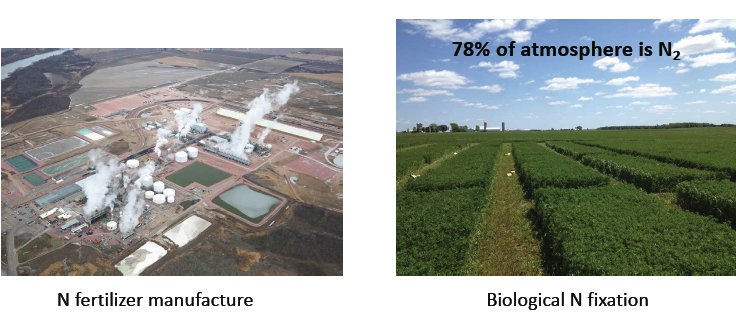

Nitrogen essential
Carrie Laboski, UW-Madison Extension Soil Scientist, presented expert testimony about the importance of nitrogen for crop yields. She described nitrogen as “the nutrient that most often limits growth of non-leguminous crops.”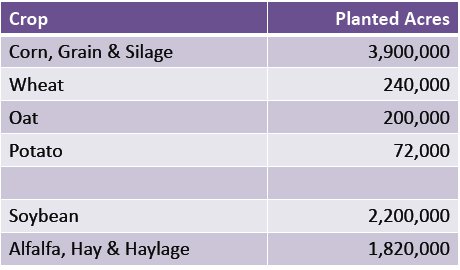

Citing data from National Agricultural Statistics Service from 2018, Laboski told the committee that 52 percent of cropland acres were grown in non-leguminous crops such as corn, wheat, oats and potatoes. Leguminous crops such as soybeans and alfalfa accounted for 48 percent of cropland acres.
Laboski explained that farmers needed to add nitrogen into their cropping systems in order to achieve a profitable yield. She said that there are many variables that affect the level of need to add nitrogen, including available nitrogen from the soil, timing of application, seed variety and weather.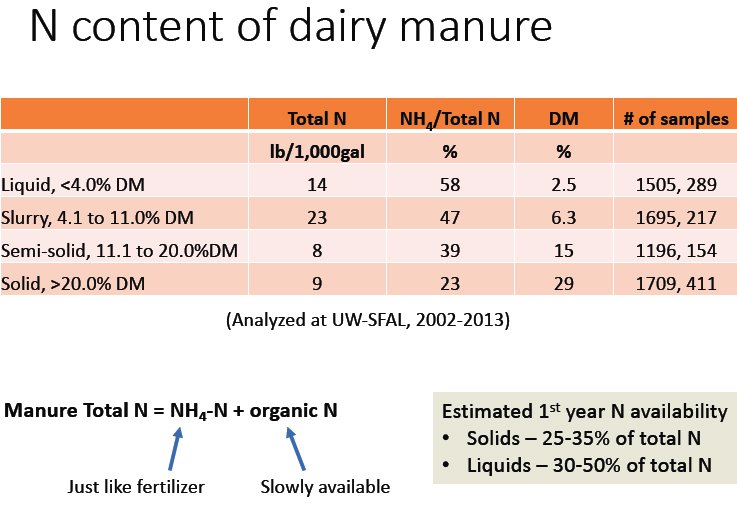

Laboski said that there are problems with using application of manure as a nitrogen source as well. The main problem is variability in the nitrogen content and differing rates of release of the nutrient to the crop. Overall, she explained that first year nitrogen availability from manure solids was 25-35 percent of total nitrogen, versus manure liquids, where 30-50 percent of total nitrogen was available in the first year.
“It is possible to use profitable rates of nitrogen and not have excessive nitrogen losses,” Laboski told the committee. “A one-size-fits-all approach to nutrient management will not improve water quality - approaches must be customized for each field and resource concern, and will likely produce tradeoffs between surface water, groundwater and air quality.”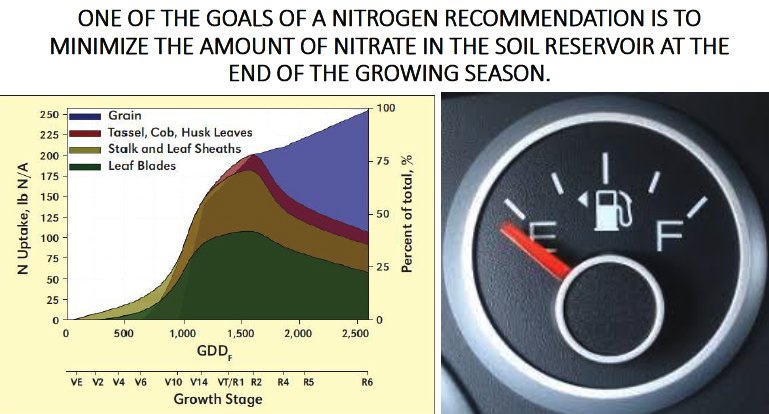

Nitrogen unique
Agronomist Steve Hoffman made an analogy between car maintenance and the approach to different plant nutrients in a farming system.
“Periodically checking the oil level of an engine crankcase is a useful analogy for phosphorous, potassium and the micronutrients,” Hoffman said. “But although there is a soil reservoir of nitrogen, it is not sufficient to supply the needs of corn and other non-leguminous crops.”
Because annual application of nitrogen is required, Hoffman explained, this means that excess nitrogen will exist at the end of the growing season. Because nitrate moves readily with water in the soil, it is prone to moving into ground or surface water as the soil drains.
“This means one of the goals of a nitrogen recommendation is to minimize the amount of nitrate in the soil reservoir at the end of the growing season,” Hoffman explained to the committee. “Large losses of available nitrogen commonly occur when excessive rainfall causes soil saturation, and availability of nitrogen can also be affected by air temperature.”
Hoffman emphasized to the committee that in order to achieve water quality protection goals, nitrogen models will need to be able to be fine tuned throughout the growing season with a variety of recalibration tools. This will allow mid-season adjustment of the current nitrogen situation versus the predicted one.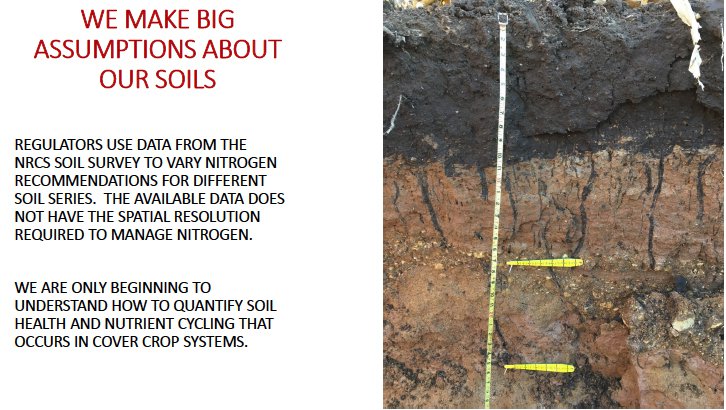

“We are just in our infancy of beginning to understand how to quantify soil health and the nutrient cycling that occurs in cover crop systems,” Hoffman said. “Right now, given the tools available, our models rely upon big assumptions about our soils.”
Hoffman said, that farmers need to be able to rely on the information about nitrogen needs, or they will continue to err on the side of caution. He listed reasons for optimism as well, including adoption of the concept of soil health, use of cover crops, joining together to protect their watersheds and interest in nitrogen use efficiency. He said that farmers are even beginning to have access to tools that can apply manure onto a growing crop.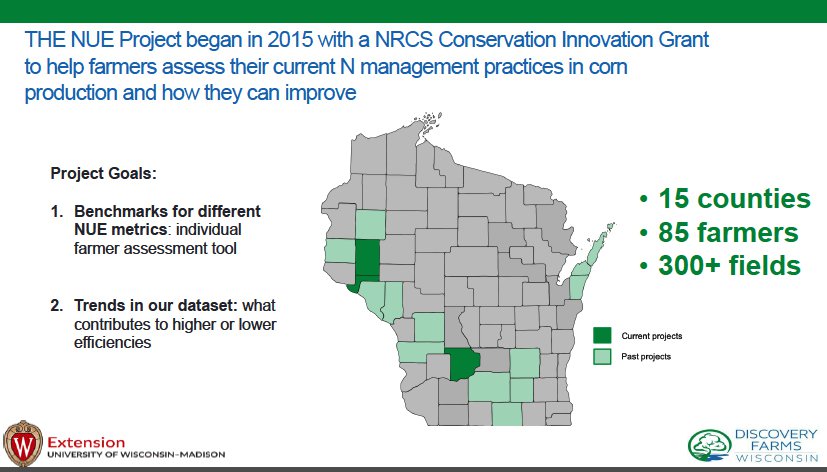

Abby Augarten, UW-Discovery Farms researcher, discussed the nitrogen use efficiency research they have conducted, their nitrogen use efficiency tool, and plans for future research.
In answer to a question from Dr. Maureen Muldoon about what their research has demonstrated about potential for nitrate leaching into groundwater, Augarten gave the following response:
“The focus of our research has mainly been runoff of nutrients into surface waters, and has mainly taken place on loam soils” Augarten said. “We have no data for groundwater, but this is one of our goals.”
This research is complicated by the fact that the timing and intensity of rainfall is highly variable, Augarten explained. Ultimately, we would like to be able to demonstrate how much excess nitrogen leaches into groundwater in a typical year with about 30 inches of rainfall at different rates of application of nitrogen.
“Farmers are under extreme pressure to improve the efficiency of their use of added nitrogen,” Augarten said. “This is financial pressure as well as pressure to protect groundwater from contamination with nitrate.”
The nitrogen use efficiency tool we have developed is easy for farmers to use, and calculates the risk for nitrogen leaching by assessing how much applied nitrogen is not taken up by the crop. The research that has gone into the development of this tool has taken into account 300 site years of data in 15 counties, working with 85 farmers on more than 300 fields.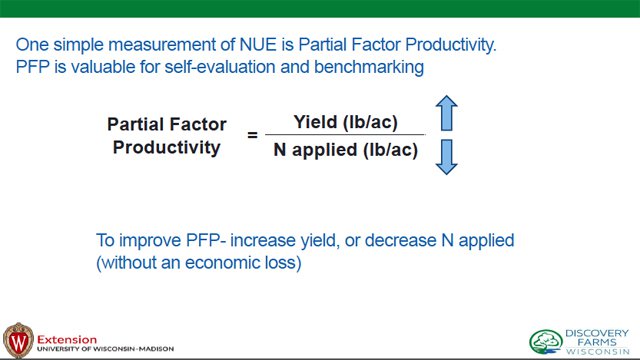

The output of their tool is called ‘partial factor productivity’ (PFP), and is the result of dividing the yield in pounds per acre by the amount of nitrogen applied in pounds per acre. An improvement in PFP means there has been an increase in yield along with a decrease in amount of nitrogen applied. The calculation, according to Augarten, is complicated by variable rates of nitrogen that are contributed by different types of manure and amount of nitrogen available from that manure.
Information about Discovery Farm’s Nitrogen Use Efficiency research and tool can be found at http://www.uwdiscoveryfarms.org/on-farm-projects/nitrogen-use-efficiency.




